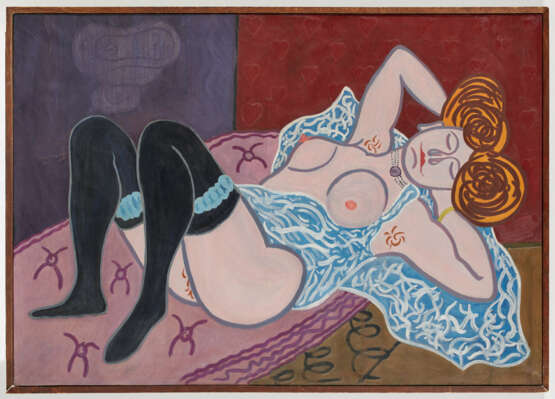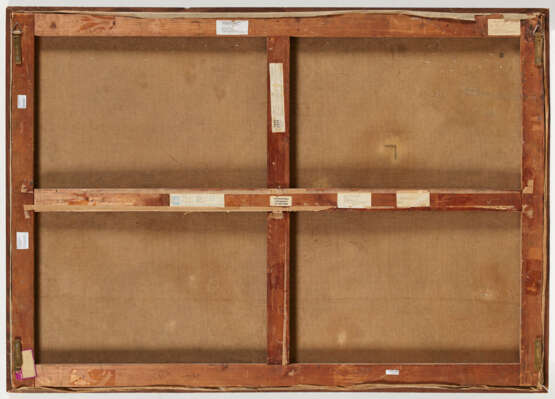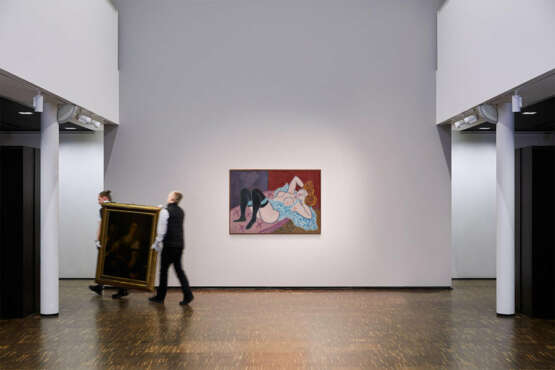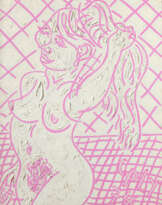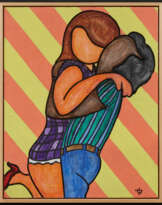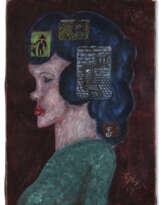ID 1302397
Lot 12 | William Nelson Copley. Lady Be Good
Estimate value
€ 70 000 – 90 000
1919 New York - 1996 Key West
Title: Lady Be Good.
Date: 1953.
Technique: Oil on canvas.
Measurement: 114 x 162cm.
Notation: Signed and dated in the depiction in the necklace: CPLY. Inscribed verso on stretcher: LADY BE GOOD.
Frame/Pedestal: Framed.
We thank Mr. Anthony Atlas, William N. Copley Estate, New York, for the kind, scientific support.
The work was later exhibited under the title "Reclining Nude".
Provenance:
- Kasper König Collection, Berlin (gift from the artist)
Exhibitions:
- Galleria Montenapoleone, Milan 1954
- Kunsthalle Bern 1980 (label verso)
- Centre Pompidou, Paris 1980/1981 (label verso)
- Stedelijk Van Abbemuseum, Eindhoven 1981
- Badischer Kunstverein Karlsruhe, 1981
- Kestner Gesellschaft, Hannover 1995
- Aargauer Kunsthaus, Aarau 2000 (label verso)
- Museum Frieder Burda, Baden-Baden 2012
- The Menil Collection, Houston 2016
- Fondazione Prada, Milan 2016/17
- Paula Modersohn-Becker Museum, Bremen 2017/18
Literature:
- Exhib. cat. William N. Copley, Musée national d'art moderne Centre Georges Pompidou Paris/Kunsthalle Bern, Bern/Stedelijk Van Abbemuseum, Eindhoven 1980, cat. no. 14, ill.
- Exhib. cat. William N. Copley: Heed Greed Trust Lust, Kestner-Gesellschaft, Hannover 1995, ill.
- Exhib. cat. Copley, Museum Frieder Burda, Baden-Baden, Fig.
- Exhib. cat. William N. Copley, Fondazione Prada, Milan and The Menil Collection, Houston 2016, ill.
- Exhib. cat. Schlaf: Eine Produktive Zeitverschwendung, Paula Modersohn-Becker Museum 2017, ill.
- Exhib. cat. William N. Copley: The Coffin They Carry You Off In, ICA Miami, Miami 2019, ill.
- Omlin, Sibylle (ed.): Das Gedächtnis der Malerei, ein Lesebuch zur Malerei im 20. Jahrhundert, Cologne 2000, p. 392, ill.
After a brief phase as a gallery owner, the American William N. Copley devoted himself entirely to his work as an artist in the 1950s. As an autodidact, he mainly devoted himself to figurative painting and worked completely autonomously, independent of any art-historical categories, such as abstract expressionism, which was on the rise during his lifetime. His work combines humor, eroticism, social criticism and motifs from art history and literature to create an exceptional visual language. His style can be defined by pop culture themes such as the depiction of women, sex, patriotism and automobiles as well as by his distinctive painting style, namely clear contours and a luminous, two-dimensional application of paint. By using current themes, Copley lends his works a high degree of topicality and establishes the first tendencies towards Pop Art early on. The reduction to the essential contours and the resulting visual language, which is strongly reminiscent of the comic style, increases the expressiveness of Copley's pictures.
Surrealist references
Influenced by surrealist art, Copley's works are also designed to test the viewer's existing expectations. Even at the beginning of his career, he received numerous positive reactions to his paintings from his role models such as Max Ernst, Man Ray and Marcel Duchamp, with whom he made contact during his time as a gallery owner. Shortly after giving up his gallery in Beverly Hills, Copley moved to Paris in the early 1950s, where he developed his so-called "private mythology" under the influence of the surrealist avant-garde. A repertoire of forms from which he would draw for his entire career. Here he mainly established motifs such as the male figure with a bowler hat, based on Magritte, female nudes such as prostitutes, as well as policemen and automobiles. In addition to his work as a painter, Copley is also a collector and over the years has amassed one of the most impressive international surrealist art collections.
Lady Be Good, or: Reclining Nude
His 1953 work "Lady Be Good" was also created during this time and will be exhibited at the largest Copley retrospective in 2016. It is organized by the Fondazione Prada in Milan in cooperation with The Menil Collection in Houston. The work comes into Kasper König's possession as a gift from the artist: "Copley gave me a painting as a present once, a nude that is strongly reminiscent of Henri Matisse [Reclining Nude, 1953]. There's something charming and awkward about it, but it is also a true masterpiece. It is a nude on a mattress without sheets. The buttons of the mattress are like spiders. The woman's armpit hair is painted in the same way as this mattress decor. In the top left corner there's a bidet shimmering through-he had overpainted it, but it came through again ... it is now covered, but for this reason maybe more visible than before. Somebody said to me that Copley was told to overpaint the bidet in the picture because it was regarded as indecent in America-which is indeed possible in the face of its puritan culture-which is an interesting, speculative assertion. The picture possesses a certain innocence and naiveté. It is about a male gaze, but it by no means excludes the female gaze." With the depiction of a prostitute, Copley refers to the art historical tradition of courtesan depictions such as those found in Manet or Pablo Picasso, which always place the female figure somewhere between object of lust and scapegoat. In "Lady Be Good", creative and compositional parallels can also be drawn with artists such as Pierre Klossowski.
Make Love not War
The "unknown whore" is a recurring motif in Copley's oeuvre. The artist, who wanted to free sexual hedonism from pornographic stigmas, often took the motif of the sex worker as his subject, to which he dedicated an entire exhibition "Projects for Monuments to the Unknown Whore" in 1966. Copley rejects the degradation and simultaneous fetishization of prostitutes in his work and adds an ironic undertone to the stigmatized motif: "Here the reclining nude is not the object of a disinterested aesthetic sensibility, and there is the suggestion of laughter at the idea that a reclining nude ever was". Reproaching society with its most primitive repressed instincts and liberating it from ossified thought patterns remains a permanent concern of the artist.
| Artist: | William Nelson Copley (1919 - 1996) |
|---|---|
| Applied technique: | Oil |
| Auction house category: | Post War paintings, drawings, watercolours |
| Artist: | William Nelson Copley (1919 - 1996) |
|---|---|
| Applied technique: | Oil |
| Auction house category: | Post War paintings, drawings, watercolours |
| Address of auction |
VAN HAM Kunstauktionen GmbH Hitzelerstr. 2 50968 Köln Germany | ||||||||||||||
|---|---|---|---|---|---|---|---|---|---|---|---|---|---|---|---|
| Preview |
| ||||||||||||||
| Phone | +49 221 92586215 | ||||||||||||||
| Fax | +49 221 92 58 62 4 | ||||||||||||||
| Buyer Premium | 32% | ||||||||||||||
| Conditions of purchase | Conditions of purchase | ||||||||||||||
| Business hours | Business hours
|

